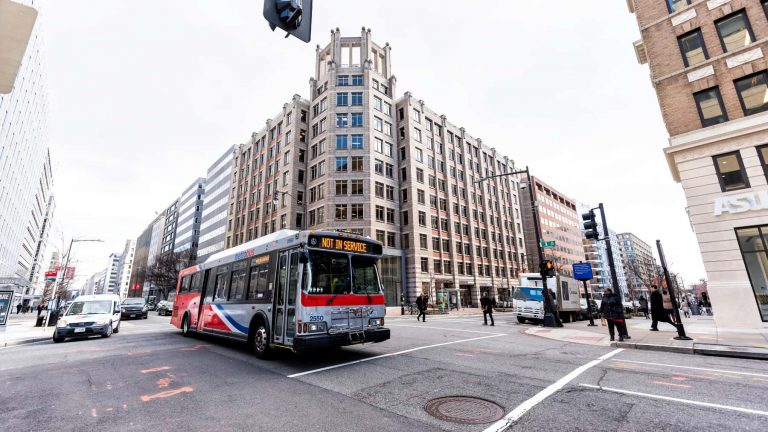
Regional Express Bus Network
Background
The Alliance recommends the creation of a regional express bus network to provide direct connections to major employment centers, as a supplement to the existing Metrorail network, by adding managed lanes to the I-66 corridor, I-495 across the American Legion Bridge to the I-270 spur and other major corridors to add to the managed lanes already in place on I-95/I-395, 495 and the Dulles Corridor/VA 267.
Demographic and Travel Realities
The metropolitan Washington region has one of the highest, if not the highest, rates of inter-jurisdictional and interstate travel in the nation.
Travelers make route and mode choices based on time savings, reliability, flexibility and cost.
Virtually all of the region’s major activity centers with rail transit supportive densities are currently served by Metrorail.
Most future suburban densities are unlikely to reach transit-supportive levels. The region’s dispersed settlement patterns lend themselves far more to express bus service, which will be not only faster, but more flexible and affordable
From its founding the Alliance has supported construction of the planned Metrorail system and Virginia Railway Express commuter rail network.
However, with these networks in place or nearing completion the Alliance believes the above realities make a regional Express Bus service on dedicated lanes a far better future investment of capital transit dollars than expansion of fixed (light or heavy) rail.
Transportation Professionals Endorse Regional Express Bus Network
The Alliance is not alone in this view.
A 2011 survey that asked area private and public sector transportation professionals what they considered to be the region’s most important transportation investments, found that a regional express bus network was ranked third behind adding new Potomac River crossing capacity and maintaining/ensuring Metro rail’s reliability as the region’s most important/productive transportation investment.
The 2030 Group Regional Transportation Priorities Study
In 2013 a coalition of District, Maryland and Virginia business leaders (The 2030 Group) commissioned a group of transportation experts to study the potential benefits of those highway and transit projects rated highest by the 2011 survey of public and private sector transportation professionals.
Services and corridors in this analysis included:
- WMATA’s 2020 Express Bus/Priority Core Network destined primarily to DC business district
- I-495/Capital Beltway MD (American Legion Bridge to I-95)
- I-495/Capital Beltway VA (Wilson Bridge/National Harbor/Oxon Hill to American Legion Bridge)
- I-66 (US 15 to Roosevelt Bridge)
- I-95/I-395 – Fredericksburg to Pentagon/Crystal City
- I-270 – US 15 to I-495
- MD 200/Intercounty Connector (I-270 to I-95)
- Northern Potomac River Crossing (Dulles/Reston/VA Route 7 to Gaithersburg/Rockville I-270)
Study Conclusions:
- Expanded Transit Ridership: Computer modeling using the Metropolitan Washington Council of Governments’ latest travel demand model found that by 2030 the network described above attracted about 21,000 daily riders or the current equivalent of the Virginia Railway Express System
- New Routes/Frequencies: The Study also concluded that increased service frequency on the above routes and added route are likely to increase ridership although it is unlikely to exceed 50,000 in 2030.
- Reliability/Flexibility: A particularly significant benefit of express bus is its ability to provide fast, reliable service to and between major activity centers with the flexibility to shift focus and capacity to adjust to changing market demand.
NoVA Transit and Transportation Demand Management (TDM) Plan
In 2012 the Virginia Department of Rail and Public Transportation (VDRPT) released its NoVA Transit and TDM Plan to examine ways to provide “safe, strategic, and seamless mobility options for rail, transit, and TDM in the greater northern Virginia region.”
The Plan studied and made recommendations in a wide range of areas including:
- Expansive commuter bus network throughout the region
- Interconnected network of high-capacity transit services in the region’s urban areas
- Network of hubs to connect people to transportation services and programs
- Coordination of local transit services across jurisdictional boundaries
- Pedestrian and bicycle facilities to improve connections to transit services and facilities
- Comprehensive regional Transportation Demand Management (TDM) strategy and programs
- Leveraging technology to enable people to make informed decisions about travel
Regional Express Corridors Examined
The Plan looked at a number of long-distance express bus networks/services that would be primarily intended to serve long distance work trips in the peak AM and PM directions. These services would use existing and future express and HOV lanes. In some cases general purpose lane use is assumed. However, it remains to be seen the extent to which reliable, time-efficient service could be provided in conventional lanes. Specific recommended corridors/segments/services included:
- I-66 — Front Royal/Haymarket/Gainesville/Centerville?
- I-95
- Conventional Lanes Caroline County to Garrisonville (Route 610)
- Express Lanes Garrisonville (Route 61)) to 495
- I-395 — HOV/Express Lanes to DC line.
- I-495 — Express Lanes
- US 17 between I-95 and future VRE Crossroads station
- Route 7 — Tyson’s Corner to Dulles Town Center
- Route 123 — Woodbridge to City of Fairfax
- Route 268 (Fairfax Parkway) — Reston to Lorton
- Route 294 (Prince William Parkway — Manassas to I-95
- Dulles Greenway/Dulles Toll Road/Dulles Connector Road — Loudoun County to DC
As is so often the case, when the plan was completed no funding existed to implement its recommendations.
Additional observation: Given that this was “collaborative study” involving many jurisdictions and “stakeholders/interests” the exercise cast a broad net identifying a wide range of possibilities without attempting to identify those most likely to make the greatest difference, or be the most cost effective.
Invest in a Better Regional Express Bus Network
If better transportation is a priority to you, your family, or your business—invest in the NVT Alliance. Your tax-deductible contribution is an investment in the quality of life of Northern Virginia.
Donate to the AllianceAdditional Resources
Transportation planning is dispersed at multiple levels (state, regional, sub-regional, and local) and further by mode of travel. No one entity or level has ultimate responsibility for planning. More about transportation planning in the DC Metro Area.